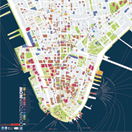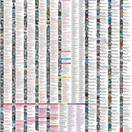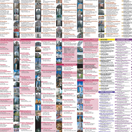




SCOPE |
: |
Cultural Mapping |
500,000 maps were printed and distributed for free in 5 updated editions January, June, & Sept, 2002, Sept, 2003 and Sept, 2006. |
||
EXHIBITIONS |
: | Columbia University Graduate School of Architecture Planning & Preservation 2002 |
COLLECTIONS |
: | Permanent Collections Library of Congress |
New York Historical Society |
||
| Oklahoma City National Memorial & Museum |
DESCRIPTION
The DowntownNOW Map grew out of meetings of the Cultural and Historic Resources Committee of the New York New Visions Design Coalition, the pro bono group of design organizations who came together in the aftermath of 9/11.
The map served four purposes: to enlarge the focus of rebuilding beyond the 16 acres and to see downtown as a true river-to-river community, to call attention to the cultural and historical richness of the area, to get people back downtown so that these small institutions would survive, and to have a single document for planning. Now fully distributed in its fifth edition, it has become a vital resource providing updated, in-depth information, and it has become a snapshot of how the area has been transformed since 9/11.
The map been used widely by everyone from the Mayor, city planners, schools residents and tourists and has focussed attention on using culture as a glue for revitalizing communities. It was instrumental in preserving the historical heritage of downtown as it was the first time all of the various landmark listings in the area were coordinated and illustrated.
The map served four purposes: to enlarge the focus of rebuilding beyond the 16 acres and to see downtown as a true river-to-river community, to call attention to the cultural and historical richness of the area, to get people back downtown so that these small institutions would survive, and to have a single document for planning. Now fully distributed in its fifth edition, it has become a vital resource providing updated, in-depth information, and it has become a snapshot of how the area has been transformed since 9/11.
The map been used widely by everyone from the Mayor, city planners, schools residents and tourists and has focussed attention on using culture as a glue for revitalizing communities. It was instrumental in preserving the historical heritage of downtown as it was the first time all of the various landmark listings in the area were coordinated and illustrated.
